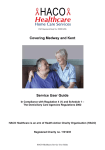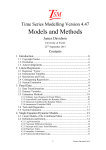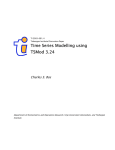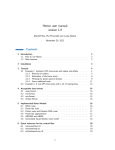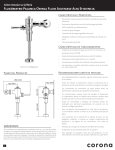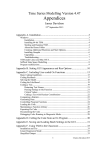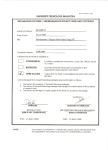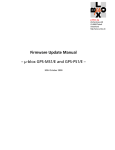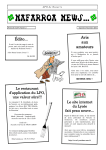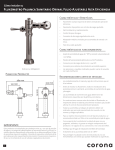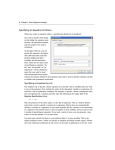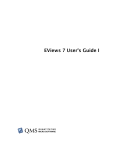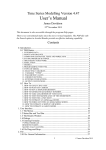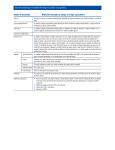Download A Guided Tour of TSMod 4.03 - Time Series Modelling (TSM)
Transcript
A Guided Tour of TSMod 4.03 Review by: Ana-Maria Fuertes, Marwan Izzeldin and Anthony Murphy Journal of Applied Econometrics, Vol. 20, No. 5 (Jul. - Aug., 2005), pp. 691-698 Published by: Wiley-Blackwell Stable URL: http://www.jstor.org/stable/25146387 . Accessed: 21/08/2012 06:42 Your use of the JSTOR archive indicates your acceptance of the Terms & Conditions of Use, available at . http://www.jstor.org/page/info/about/policies/terms.jsp . JSTOR is a not-for-profit service that helps scholars, researchers, and students discover, use, and build upon a wide range of content in a trusted digital archive. We use information technology and tools to increase productivity and facilitate new forms of scholarship. For more information about JSTOR, please contact [email protected]. . Wiley-Blackwell and John Wiley & Sons are collaborating with JSTOR to digitize, preserve and extend access to Journal of Applied Econometrics. http://www.jstor.org JOURNAL OF APPLIED ECONOMETRICS J. Appl Econ. 20: 691-698 online inWiley Published (2005) InterScience DOI: (www.interscience.wiley.com). 10.1002/jae.825 A GUIDED TOUR OF TSMod 4.03 ANA-MARIA IZZELDINa AND ANTHONY MURPHYb FUERTES,a* MARWAN a Cass Business b Management London, UK School, City University UK School, Lancaster University, SUMMARY We review the time series econometrics TSMod. package new The features in TSMod 4.03, in April released 2004, are described and its potential for teaching is analysed. Copyright ? 2005 JohnWiley & Sons, Ltd. 1. INTRODUCTION flexible Ox package for time series econometric is an efficient, user-friendly, analysis a There are of linear and nonlinear models. univariate and wide multivariate, range offering several things that we particularly like about TSMod. is easy to use since it features a menu driven, click and point, graphical user First, TSMod interface (GUI). Thus the user does not need to know Ox, the object-oriented, matrix programming TSMod the fact that TSMod is written in efficient Ox language which is at the heart of TSMod. Moreover, code makes it fast and hence particularly suitable to conduct Monte Carlo or bootstrap simulations. GARCH and related Second, the number of nonlinear time series parameterizations?including models?offered and forms of conditional heteroscedasticity, by regime-switching long memory in popular packages such as EViews, far exceeds what is currently available TSMod's menus Rats, S-Plus and TSP. Third, it is an integrated package. Using estimate and test a model and then generate Pc-Give, it is straightforward menus, using the selected model. the TSMod forecasts to buy. (Currently, the time-limited, academic version Fourth, it is inexpensive the author of TSMod, plans to charge a modest free. However, James Davidson, the future.) * Correspondence EC1Y 8TZ, UK. Copyright ? to: Professor E-mail: 2005 Ana-Maria Fuertes, Faculty [email protected] John Wiley & Sons, Ltd. of Finance, Cass Business School, to set up, of TSMod 106 Bunhill is fee for it in Row, London 692 SOFTWAREREVIEW to estimate any nonlinear dynamic equation that can advanced users can use TSMod be supplied as a function in Ox code. They can also call TSMod routines from within Ox when, for example, running Monte Carlo experiments. Of course, one can use TSMod just to calculate summary statistics and practice the standard Finally, courses. However, OLS regression tools taught in basic undergraduate econometrics this would be a waste of potential since the main comparative advantage of TSMod lies in its advanced features. is aimed primarily at researchers and students who have a good understanding TSMod of the that they are applying. econometric methods 2. OVERVIEW large range of models can be estimated using TSMod. In order to get a feel for the capabilities of TSMod, we looked at some recent financial econometrics and van Dijk textbooks?Franses some out Mills and (1999), Tsay (2002) (2000), Wang (2002)?and picked widely used models. We then checked whether or not TSMod facilitates them. TSMod provides the following tools A inter alia: ARIMA and ARFIMA easy model selection; model estimates by ML with a pre-set maximum order feature allowing Bilinear autoregressive models by ML; ML and QML estimates of conditional heteroscedasticity models including GARCH, FIGARCH, EGARCH and threshold GARCH-M; ARCH, APARCH, HYGARCH, switching models switching, Hamilton's dynamic Markov Regime including simple Markov transition model and smooth components by ML; switching model, explained switching equations using OLS, IV, 2SLS and GMM estimation methods; and FIML methods; systems using 3SLS, SUR, LIML/LGV Nonlinear GMM models; least squares (FMLS) estimation and models with equilibrium relations such as Fully modified error correction models (VECM); (ECM) and vector error correction models single-equation bivariate (Naradaya-Watson) regression models; Nonparametric standard errors and p-values for test statistics. Parametric bootstrapped Linear Linear listed above can in that many of the models is its flexibility One powerful feature of TSMod a GARCH an to ARFIMA model with estimate it is For be combined. possible example, easily mean t random error including exogenous in both the conditional skewed Student's regressors can be estimated in both the time and variance equations. ARFIMA models and conditional frequency domains. There are a number of other attractive features. For instance, parameters can be fixed or subject to inequality constraints using a logistic map. Wald tests of linear restrictions are available. Score/LM tests can be calculated. The concentrated criterion function can be plotted and conditional moment and recursive estimation options are available. Numerical in one or two dimensions. Rolling out the BFGS algorithm with the option of using the simulated is carried using optimization In addition, stochastic simulation of the aforementioned for values. starting annealing algorithm ex ante point forecasts including median forecasts of the models can be carried out and multi-step mean and variance alongside 95% interval forecasts can readily be produced. Copyright ? 2005 John Wiley & Sons, Ltd. /. Appl. Econ. 20: 691-698 (2005) SOFTWAREREVIEW 693 2.1. Recent Features The current version is TSMod version 4.03. A useful review of the earlier version 3.24 can be as TSMod is continually evolving, the latter is already a little out found in Bos (2004). However, in the first has produced three new versions of TSMod of date. The fact that James Davidson author is very open to four months of 2004 bears this out! We should also note that TSMod's suggestions and comments and, quite importantly, responds very promptly to queries. We envisage an active internet discussion list for TSMod users in the near future! The major changes in v4.03 relative to v3.24 are: (i) The addition of useful system estimation routines?simultaneous equations models, VECMs, univariate and multivariate Markov-switching the ability to estimate user-programmed equations and multivariate GARCH models?including tests of cointegrating rank and MINIMAL nonlinear systems; (ii) Johansen-type analysis of the space; (iii) the graphical user interface has been improved and icons for common cointegrating commands have been added. The multivariate GARCH model may interest many users. In the univariate case, the basic 1/2 GARCH model may be expressed as yt = y + ut where ut = ht et, et ~ iid(0, 1) and ft(L)ht = K + a(L)ut. The multivariate extension of this has the vector form ut = H/ ef, where H, = ~ iid(0, C) where C is a correlation matrix with ones on the main diagonal. diag(h,), er 3. GETTING STARTED 3.1. Installation inWindows instructions for installing TSMod and Linux Comprehensive given in the documentation (Appendix A) provided with the program. The can be downloaded from James Davidson's web page http://www. as GnuDraw, Several other necessary software components?such 201/. are bundled along with TSMod. In order to use TSMod in the standard GUI or windows point-and-click operating systems are latest version of TSMod ex. ae .uk/~jehd GnuPlot and OxJapi? form, the following two programs need to be installed: (i) the free console version of Jurgen Doornik's Ox 3.3 program which may be downloaded from http: / /www. doornik. com/; (ii) the free Java Runtime from http: Environment down / / j a va. s un. c om /j2se/1.4.2/ (JRE) downloadable load. html. Installation is completed in four steps. The current version of the program usually . resides in c : /program files/ox/packages Most users will probably launch TSMod using an easily set up Windows shortcut. However, it can also be run as a module from within OxEdit (or GiveWin) by clicking on File?>Open-^ Run and then Modules-^Run TSMod Module. A nice feature of TSMod Default is that advanced users can call the TSMod routines and access their output when programming Monte Carlo experiments or bootstrap simulations in Ox code. 3.2. Documentation is a learning curve when first using TSMod, because the program is so flexible, but it is not very steep. TSMod comes with a range of documentation: (i) a Guide to the package; (ii) a User's Manual which is also accessible the program Help pages; (iii) a series of Appendices; through and (iv) a Programming Reference. There Copyright ? 2005 John Wiley & Sons, Ltd. J. Appl Econ. 20: 691-698 (2005) 694 SOFTWAREREVIEW is not a commercial package as yet and it is designed for relatively experienced users. the Guide is too cryptic at times when describing the large variety of models which Nevertheless, TSMod can handle. New users would find it helpful if some of the more popular models were described in more detail. For instance, the sequence of menu and option settings used to set them TSMod up could be discussed. Basic the cointegrating space would also be presented so that new replicate the results. New TSMod users should mation they need is set out menus and options available examples of how to test joint parameter restrictions and analyse be useful. More detailed examples using available data sets could users could familiarize themselves with the software by trying to since print out a copy of the User's Manual there. The User's Manual provides a detailed in the GUI version of TSMod. However, if illustrated via examples based on real data, it would be a lot of the infor of the description some of the tech more fun to read aspects were ordered index of contents for easy reference would be very through it. Also an alphabetically useful in order for the user to find specific information quickly. Advanced users will find the Appendices and the Programming clear and helpful. The Appendices show how Reference to include user-coded in the TSMod routines (Ox) functions routines, how to call TSMod from an Ox program and how to generate artificial data (simulations) using the different mod nical els available. 3.3. Data Handling can read data from sources: (i) Excel (.xls) and Lotus (.wkl,.wks) the following work sheets; (ii) Ox/GiveWin (.in7, .dat) datafiles; (iii) Stata (.dta, versions 4 to 6) datafiles; (iv) Gauss (.dht) datafiles; (v) ASCII files with the .mat file extension containing a data matrix with variables in columns, observations in rows and the number of rows and columns in the first line. Data can not to Stata or be written to Excel, Lotus, Ox/GiveWin and ASCII data files but, unfortunately, Gauss data files. Of course, a program like StatTransfer can be used to transfer data from other in TSMod. data file types. Two or more data files can be merged if you play around enough TSMod is a reasonably robust package. It will crash on occasion with a variety of model settings. However, in almost all cases, the problem is resolved when you start up TSMod again. The latest settings are restored and one can estimate the model previously set up. New users should generally reset the settings in TSMod whenever they start formulating TSMod a new model. 4. USING TSMOD FOR TEACHING lecturer might choose to adopt believe that the main reasons why an applied econometrics time TSMod for teaching purposes are (i) TSMod is an advanced package offering state-of-the-art and models, GUI and (iii) TSMod series estimation methods (ii) TSMod uses a menu-driven and It is ideal for research purposes and for teaching advanced undergraduate is inexpensive. courses. Students and researchers who can program in Ox will also econometrics postgraduate certainly benefit from the easy interaction between TSMod and Ox. Below we outline a series of We advantages Copyright ? (pros) and disadvantages 2005 John Wiley & Sons, (cons) of TSMod. Ltd. /. Appl. Econ. 20: 691-698 (2005) SOFTWAREREVIEW 695 4.1. Transforming Session Data, Logs and Data Summaries scaling, etc.) (logarithms, lags, differences, Through the GUI, most common data transformations can be can be performed, dummy variable and trends can be created and individual observations transformations will have to be performed prior edited on the fly (pro). However, more complicated to reading the data in TSMod since the package does not have a calculator or algebra editor tool similar to those in GiveWin (con). Take the daily S&P series used in Franses and van Dijk (2000). Data Transf It can be transformed into daily returns through Setup? ormation-*Log creates a new variable called DlLog_S&P. The user can then This automatically Dif f erence. rename the series if desired. The new data file (that contains both the original series and the Data?>-Save. Various default file types can transformed series) can be saved through File-* be specified (pro). A listing of data transformations appears in the session log file and on the screen (pro). How does TSMod handle missing data? Suppose that a single observation for a single variable, from the data set. TSMod will estimate a model say the 30th data point, is missing including number 30. This is fine for most this variable by dropping all observations up to observation but not if you want to estimate a static the focus of TSMod, time series models, dynamic OLS regression. One nice feature of TSMod is that the output of the session can be cumulated in an output/session log file (pro). This feature is useful for teaching purposes. For example, when correcting course this provides an easy way to re-trace the student's steps in the econometric anal work/assignments Enable ysis. This can be specified at the beginning of a session through File-^Results-> or New Results File. Background Saving Perhaps the default setting should be to keep a session log. Of course, the user can save selected results using File->Results-^Save Text. Selected One can produce summary statistics through the Actions? Sta Compute Summary Besides the usual statistics, the latter provides several I(0)/I(1) tests by tistics options. default (pro). These are Lo's RS test, the KPSS test, the Phillips-Perron test and Robinson's d test. In contrast with other common packages such as EViews, it gives the observation number at which the max and min occurs (pro). Perhaps the data transformation, summary statistics and data graphs options should appear under the same menu heading. to enable statistics, be added to the summary statistics dialogue calculated in one go (con). 4.2. Econometric In addition, correlations a check box could and so forth to be Analysis Different estimators, as well as the sample to be used, can be chosen through Setup->Esti and mation and the use of Sample option. One can also specify systems estimation differenced data. The regression model is specified using Model->Linear Regression. One can also access IV, GMM, 2SLS, 3SLS and FMLS using this menu. ARFIMA, GARCH, models and other parameterizations regime-switching involving equilibrium relations (e.g. ECM and VECM) are selected through the Mo del - Dynamic Equation option. tests alongside the estimation results (pro). By default, TSMod reports several diagnostic These include the residual skewness and kurtosis, the Jarque-Bera test for normality, a residual test (Box-Pierce) autocorrelation and a test for heteroscedasticity test for the (Box-Pierce The and squared residuals). lag length for these tests can be set using Options->Test Copyright ? 2005 John Wiley & Sons, Ltd. J Appl. Econ. 20: 691-698 (2005) 696 SOFTWAREREVIEW since the default value of 12may not be appropriate inmany cases. Diagnostics Options, tests for autocorrelation and heteroscedasticity, Additional including neglected ARCH effects, may also be called for (pro). In the case of ARMA models, TSMod reports the real and imaginary part of the AR roots and their moduli (pro) but not the inverted MA roots as EViews does (con). The reported standard errors are obtained from theWhite robust covariance matrix by default. However, or the Newey-West either the conventional HAC robust standard errors may be selected instead and Diagnostics Options. using Options->Test bivariate regression module and some TSMod also offers a nonparametric (Naradaya-Watson) such as FMLS. However, TSMod does not advanced estimation methods for cointegrating models include a number of estimators which are widely used in conventional undergraduate econometrics courses such as GLS estimation least squares in the context of heteroscedastic (e.g. weighted and time series and baseline such as fixed models, errors), logit probit panel time series models a wide range of time series models within the GARCH effects and random effects (con). However, class are provided to deal with conditional heteroscedasticity (pro). With regards to inference, it is possible to compute score or conditional tests of hypotheses using Test Take the model Statistics. yt = a + Pixu + fi2x2t + et Actions->Compute and suppose that we want to test H0 :Pi + 4?2 = 1. In EViews this can be done simply by writing = 1 in the test window. However, it is less obvious how to do this in TSMod and c(2) + 4 x c(3) so, as noted earlier, it would be useful if the TSMod manual contained some data-based examples (con). It is possible to impose multiple parameter restrictions, such as the one above, in estimation Parameter Constraints (pro). Simple Chow breakpoint tests are not through Models menus set in TSMod (con). after model estimation from the up readily TSMod allows for recursive estimation based on increasing-size windows or a fixed-size rolling window and the sequence of parameter estimates can be subsequently plotted (pro). With regards to ARMA analysis, the estimated coefficients for AR models are virtually equal to those obtained the estimated coefficients and in EViews (with the backcasting option off) and Pc-Give. However, standard errors in ARMA models can differ. Table I reports estimates for an ARMA( 1,1) model series over the period 1/06/86 to 12/31/97 from Franses and van of the daily S&P Composite Dijk (2000). This example illustrates that theMA parameter estimate in TSMod is nearly identical to that from EViews and Pc-Give but with opposite sign! The reason for the latter is that their ARMA estimation In TSMod, of the MA lag polynomial. routines are based on different default parameterizations ? ... ? accounts the which for the latter is 0(L) = 1 ? OiL apparent sign discrepancy. The 0qLq, robust (White-type) standard errors for AR model estimates TSMod and EViews heteroscedasticity as Table I are virtually identical. However, they differ somewhat in the case of ARMA models, estimates Table I. ARMA(1,1) Parameter (robust 0.00049 (0.0002) 0.00048 (0.0001) Intercept -0.71519 (0.1351) MAI -0.75705(0.1104) * Using Copyright the ARFIMA ? 2005 1.01 package John Wiley for Ox & Sons, 0.00048 and Ooms, 2003). Ltd. J. Appl (0.0001) -0.73553 (0.2072) (0.0929) 0.77509(0.0863) 0.75706(0.1757) (Doornik 10.0* Pc-Give 4.1 EViews TSMod4.03 -0.71519 AR1 s.e.) Econ. 20: 691-698 (2005) SOFTWAREREVIEW 697 illustrates. The reason for this discrepancy and Pc-Give are is not obvious. The White standard errors from TSMod close. relatively can be estimated. At first sight (i.e. when using the default range of ARCH models users seem to results differ the greatly from those in other packages. However, specifications), that TSMod permits. Take a simple should be aware of the different ARCH parameterizations for the 'ARMA-in-squares' form of the GARCH model. Estimates GARCH(1,1) equation are users want to for the 'conventional form' of reporting default. However may opt reported by A wide and through Options-*ML on model how the GARCH depending 1' and 'Type 2') are reported. Most Garch Care should also be taken in that, Options. two different intercepts (referred to as Type probably prefer the latter type of intercept = and Pc-Give, which conforms with that reported in EViews namely 8 in the equation of co in fi(L)(o2 - oo) ? 8+ whereas the former is TSMod + reports as2__x /tof_i? ae2_v By default, the 'Type 1' intercept but one can always revert to the conventional one through Options-^ML and Garch Opt i ons. Perhaps itwould be more intuitive if the conventional parameterization were the default ones, instead of the other way round. Table II reports the GARCH(1,1) options estimates and standard errors for the S&P series. parameter As noted earlier, one of the strengths of TSMod is the wide and range of univariate results multivariate richer models it offers by readily dynamics is written, users will for nonlinear time series different models, combining In addition, TSMod allows analysis. e.g. an ARFIMA-GARCH specifica tion. Inevitably, the current version of TSMod has some limitations in terms of modelling/inference tools but the author is very open to suggestions. VAR models may be estimated in TSMod but the impulse response to an innovation shock is not automatically It would be generated. useful if the MacKinnon-Haug-Michelis tests were added to critical values for cointegration the package. As TSMod stands, some users may prefer alternative packages such as Pc-Give to vectors. Stochastic volatility and state space carry out Johansen-style analysis of cointegrating are not included in TSMod but they both may be estimated using the (Kalman filter) models Ox packages Stamp and SsfPack/SVPack. Bandpass (frequency) filters such as the Baxter-King, fixed and Christiano-Fitzgerald length Christiano-Fitzgerald asymmetric full sample filters would also be nice to have. The forecast capabilities of TSMod could be expanded to somewhat provide a of range forecast baseline Diebold-Mariano test. dependence to generate measures, accuracy type forecast accuracy combined Table II. GARCH(1,1) 4.03 0.00065 (0.0001) Intercept (mean) Intercept 0.00133 (GARCH) Square Copyright root of Type ? 2005 2 intercept John Wiley as reported & Sons, in TSMod 4.1 0.00065 (0.0001) GARCH-AR 0.09261 (0.0538) GARCH-MA 0.89261 (0.0607) * (robust EViews 1.72e-06 (0.0005)* and to conduct predictor estimates Parameter TSMod forecasts tests and the Pesaran-Timmermann s.e.) Pc-Give 0.00065 (0.0001) 1.701e-06 (6.32e-07) 0.09174 (0.0514) 0.89438 (0.0432) 10.0 0.09092 0.89527 (6.28e-07) (0.0514) (0.0432) output. Ltd. /. Appl. Econ. 20: 691-698 (2005) SOFTWAREREVIEW 698 4.3. Graphs Unlike other Ox packages, TSMod does not make use of the graphics menu offered by GiveWin. Instead it comes with its own graphical platform which provides graphs with the same GiveWin the graphics capabilities in TSMod are reasonable. They are on a layout and precision. Overall, with those in EViews. and in packages such as However, par they lag behind those in GiveWin use and of the GiveWin interface directly. Pc-Give, TSP Stamp which make Data plots include time series plots, correlograms, histograms and normal QQ plots. Equation plots include actual values and fitted values, residuals, conditional variances, ex ante forecasts and plots of recursive and rolling parameter estimates. In terms of precision and colour display, the TSMod graphics are nicer than those in EViews. to a range of file types but not with ease if compared, TSMod graphs may be exported/saved for instance, with GiveWin. Moreover, it would be nice if the graphics saving capabilities were enhanced and some frequency domain plots were added. 5. CONCLUDING REMARKS research using time series TSMod is an inexpensive, easy to use, flexible package for econometric data. TSMod currently dominates most econometrics packages in terms of the variety of nonlinear it can handle. It can be used advantageously for teaching advanced time series specifications courses. We it and and recommend highly undergraduate hope that James Davidson postgraduate will to produce continue regular updates. REFERENCES Bos CS. 2004. Time series modelling using TSMod 3.24. International Journal of Forecasting, 20(3): 515-522. JA, Ooms Doornik M. 2003. Computational moving fractionally integrated Franses PH, van Dijk D. 2000. Press: Cambridge. Mills TC. bridge. Tsay RS. Wang P. Copyright The 1999. 2002. 2002. ? Econometric Analysis Financial 2005 average Non-linear Modelling of Financial Econometrics. John Wiley & Sons, of maximum likelihood of autoregressive estimation aspects 41: 333-348. models. and Data Statistics Analysis Computational in Empirical Time Series Models Finance. Cambridge University Time of Financial Series. Routledge: Time & John Wiley London. Ltd. J. Series. Cambridge Sons: Chichester, Appl. University Press: Cam UK. Econ. 20: 691-698 (2005)










